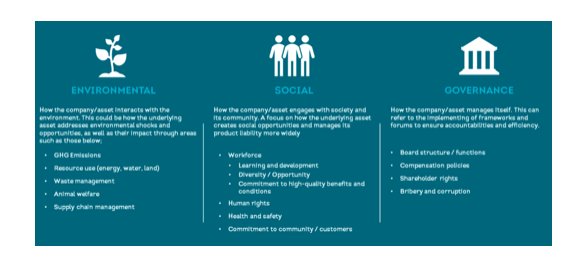Socially responsible investing is widely discussed but thinly understood.
There’s no denying that the demand for a new style of investing that weighs environmental, social and governance (ESG) factors in portfolio selection is a massive worldwide trend. Investors seek a better understanding of the societal impact of their portfolios.

However,one big challenge for the socially responsible investment movement is creating reporting and disclosure standards among policymakers, stock exchanges and regulators to make it easier for investors to accurately assess corporate performance on key ESG metrics.

This asset class is still a work in progress in some ways and investors would be well-advised to make sure they understand some basic issues before diving in.
How’s a portfolio constructed? Is it diversified or sector-focused? Do the performance metrics that govern a fund apply to individual industries or all holdings? How reliable is the data assessing ESG performance?
Expanding Market
No question that greater investor awareness about environmental problems, climate change and income inequality are propelling big changes in investing priorities and the way financial firms structure their products.
Socially responsible investing has grown by 34% to $30.7 trillion worldwide over the past two years, according to data compiled by the Global Sustainable Investment Alliance.
Some ESG investment products focus on negative screening, in which financial professionals identify issues such as pollution, animal cruelty, tobacco and plastics production they don’t want their investors’ money associated with.
Others follow a more comprehensive approach called ESG integration. Practitioners analyze corporate reports, filings and other sources to size up a company’s strategic goals and operational issues and their impact on the environment and society.
Raging Debate
ESG investors also need to keep their eyes wide open about their expectations for returns.
First, there’s no consensus in the academic research about whether there’s a positive link between ESG-focused portfolios and competitive investment returns.
One problem is that there’s no standard, global methodology for how ESG investments are put together. Another is that sustainable investing is a relatively new phenomenon, which makes back-testing and statistical analysis of long data series difficult.
Also, ESG portfolios are so varied, with some being focused on specific sectors and others broadly diversified, that it’s difficult to compare performance.
Greenwashing
Another big challenge for the socially responsible investment movement is creating reporting and disclosure standards that allow investors to size up potential ESG investments.
Investors also need to be on the outlook for “greenwashing,” in which companies make false or misleading claims about the impact of their ESG-focused strategies that don’t add up under closer scrutiny.
Earlier this year, the European Union agreed on a new law that forces asset managers, insurers and pension funds to disclose the environmental risks in their investments, in part to crack down on misleading ESG claims.
Takeaway
Given the amount of money rushing into sustainable investing, both regulators and investors will need to be discerning about what’s truly an ESG investment.
For investors, data quality is key. When considering a potential investment in an ESG-focused fund, make sure the metrics underpinning the environmental, social and governance impact are reliable and relevant.
ESG investing is an exciting, new trend in global finance. Yet it’s still early days and investors should be discerning about which funds deserve a serious look and which aren’t quite ready for prime time.
Photo Credit: Steve Sellers via Flickr Creative Commons

